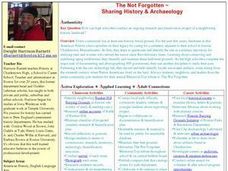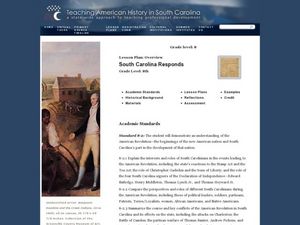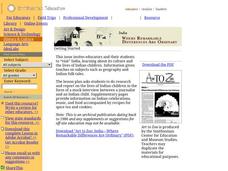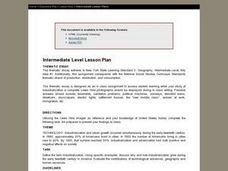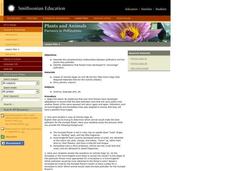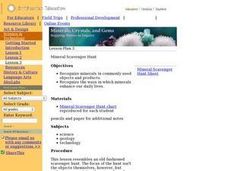Curated OER
the Not Forgotten - Sharing History & Archaeology
Students create a catalog of gravestones in a cemetery that includes a burial ground from the Revolutionary War. They photograph and document the grave sites, research the Battle of Bunker hill and work with community members to create...
Curated OER
South Carolina Responds
Students examine and explain the events that lead up to the Revolutionary War. For this Revolutionary War lesson, students summarize and evaluate several of the major battles that defined the Revolutionary War.and major battles involving...
Curated OER
The First Ladies
High schoolers compare two First Ladies. In this American history lesson, students read speeches given by Barbara Bush and Hillary Rodham Clinton. High schoolers respond to questions about the speeches.
Curated OER
Lowell and the Factory System
Students examine the efforts of early American manufacturers to implement the factory system on a large-scale in the town of Lowell, Massachusetts. They examine the idealistic goals of the industrialists who financed and built the...
Curated OER
Constructing Things
Students analyze the history and art in the Constructivism movement. For this art analysis lesson, students analyze and consider the material types in the art form. Students complete image based discussion. Students work in groups using...
Curated OER
Life in THE JUNGLE
Students discuss problems immigrants may have when coming to a new country. They take on the role of a law maker from the era and create an action plan and policy based on samples they read (links provided). Students discuss ways their...
Curated OER
A Changing Society: Industrialization and Urbanization
Students participate in activities that teach them about the Gilded Age of industrialization and urbanization. In this social changing lesson plan, students answer questions, watch videos, have discussions, read texts, and more to teach...
Curated OER
India: Where Remarkable Differences Are Ordinary
Students research India and Indian culture. In this Indian research lesson plan, students research and report on the lives of Indian children. The report will be in the form of a mock interview between a journalist and an Indian child....
Curated OER
Lewis Hine
Students define the term Industrialization. They use specific examples, discuss why and how industrialization grew during the early twentieth century in America. Students evaluate the contributions of technological advances, geography...
Curated OER
Factory Conditions
In this United States history worksheet, students utilize a word bank of 10 terms or phrases to answer 10 fill in the blank questions pertaining to factory conditions and the rise of labor unions. A short answer question is included as...
Curated OER
Brucemore Mansion
Students take a closer look at Brucemore Mansion. In this Iowa history lesson, students research what life was like at the mansion during the Gilded Age and through history. Students also research the responsibilities of servants as well...
National First Ladies' Library
Martha Goes To War!
High schoolers investigate how women went to war and the contributions that they have made in history. They conduct research using a variety of resources. The information is used in order to create a class presentation and answer some...
Curated OER
Work And Resistance In America
Students investigate the history and events that surround the industrial revolution. They conduct research using secondary sources. They look reflectively at the history in order to build an idea of how the arts could have influenced the...
Curated OER
What Makes a Hero?
Here is a well-designed lesson inviting learners to consider the qualities of a hero. They describe the lives and deeds of national, state, and/or local heroes. This is a thoughtful lesson, which is part of a sequential group on heroes....
Curated OER
Susan B. Anthony: Rebel for the Cause
Students explore the suffragist, Susan B. Anthony, documents her life and era with photographs, illustrations, and interviews. It demonstates how this feminist leader simultaneously influenced events and was shaped by external forces.
DocsTeach
How Effective were the Efforts of the Freedmen’s Bureau?
Effective or ineffective? As part of a study of post Civil War America, young historians analyze a series of primary sources to evaluate the effectiveness of the Freedmen's Bureau in addressing the challenges faced by the slaves freed by...
Curated OER
More than a Hostess: The Role of First Ladies
A study of the country's First Ladies deepens understanding of their role in history.
Curated OER
Memorial Day Shoebox Parade
Learners examine the history of U.S. conflict and Memorial Day. They conduct research, develop a timeline of U.S. conflict, and create a shoebox Memorial Day parade to commemorate veterans and soldiers.
Curated OER
Pacifism vs. Patriotism in the 1920s
Students examine the philosophy of different organizations after World War I. They discover the impact of the "Red Scare" and how this affected peace organizations of the time.
Smithsonian Institution
Watching Crystals Grow
Amazing science can sometimes happen right before your eyes! The class gets cozy as they watch crystals grow. They use Epsom salts, rocks, and food coloring to create crystals. They'll observe the entire process, documenting every step...
Curated OER
Brutal British
Students read and predict the outcome of a story set during the Civil War, then map the story. To prepare for the activity, students determine why it is important to look at historical events from all angles by using primary and...
Curated OER
Plants and Animals: Partners in Pollination
Students describe the complementary relationships between pollinators and the plants they pollinate, identify adaptations that flowers have developed to "encourage" pollination, and create and draw their own "designer" flowers.
Curated OER
Mineral Scavenger Hunt
Students complete a scavenger hunt worksheet as they find examples in their classroom, at home, etc., of minerals. Excellent worksheet!
Curated OER
Create a Classroom Exhibit: Rocks and Minerals
Students bring in rocks and minerals from home. They observe them and describe them carefully, completing a worksheet. Finally, a classroom exhibit is created.


